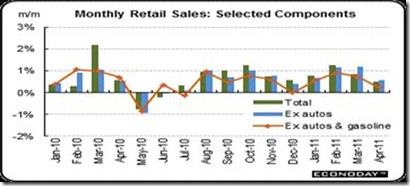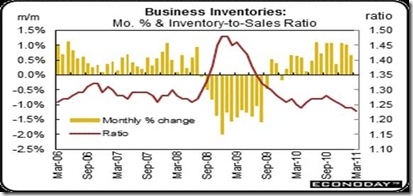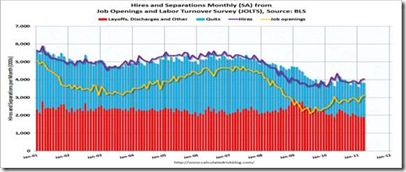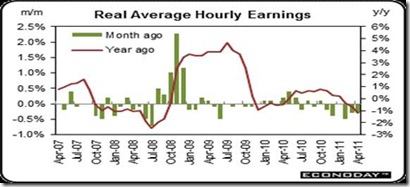Popular Economics Weekly
Neither party seems to want to tackle the unemployment problem head on. Why? Conservatives have succeeded in shifting the debate to taming the budget deficit, when any improvement in the deficit depends on creating more jobs. It is not enough to shrink government spending, in other words, because that results in more lost jobs. Nor can the debt load shrink without growing tax revenues—either in absolute terms or as a percentage of Gross Domestic Product— and tax revenues do not grow unless employers hire more employees.
The lack of focus on job creation is unfortunate, as more than 15 million are still looking for some kind of full time work, and the labor participation rate of eligible workers has dropped below 60 percent, 6 percent below the norm. What has created more jobs to date? It has mostly been the manufacturing sector exporting to other countries due to the cheaper dollar exchange rate, and the dollar won’t remain so cheap once U.S. growth kicks into high gear.
Yet domestic spending is finally beginning to grow this year, even though banks are still reluctant to lend and wages and salaries are growing less than 2 percent, as opposed to more than 4 percent during good times. Auto companies have been the biggest booster to domestic spending as they continue to sell more vehicles, which has brought retail sales close to pre-recession levels. And that only happened with the government aid to GM and Chrysler. Government spending has never been the problem, in other words, with trillions of dollars being hoarded in corporations and banks that are not being put to use.
Although a large part of retail sales come from higher gas and food prices, overall retail sales on a year-ago basis in April were steady at 7.6 percent. Excluding motor vehicles, sales were up a year-ago 6.9 percent, compared to 6.8 percent in March. Strength was led by food & beverage stores (up 1.2 percent), nonstore retailers (up 1.0 percent), and miscellaneous store retailers (up 0.9 percent). Leading on the down side were electronics & appliance stores (down 2.2 percent), sporting goods, hobby, book & music stores (down 1.9 percent), and furniture & home furnishing (down 1.1 percent).

Another sign that consumer demand is increasing was the drop in business inventories which lag business sales, indicated by the stock-to-sales ratio which fell another tenth to what is a new record low of 1.23. This reading indicates that inventories are too low. But rising sales point ahead to rising production, rising inventory build, and rising employment as well.

In fact, the softer growth in the first quarter was largely due to a sharp upturn in imports, says Econoday (Import totals are deducted from exports as part of the GDP calculations.), some deceleration in personal consumption, a larger decrease in federal government spending, and decelerations in nonresidential fixed investment and in exports. They were partly offset by a sharp upturn in private inventory investment, as businesses seem to be anticipating more demand growth.
The Bureau of Labor Statistics’ monthly JOLT Survey gives us the best employment picture. It shows a steady increase in Job openings (yellow line in graph) from the low of 2 million in 2009 to 3.1 million in April 2011. The total number of monthly Hires is also above 4 million. It is the positive 200,000 plus average monthly difference in Hires vs. Layoffs plus Quits this year that tells us payroll jobs have been trending up.

In fact, consumer spending, which makes up almost 70 percent of GDP spending, is now leading the recovery as we said last week. This is because personal income is growing again (thanks in part to those manufacturing jobs), up 0.5 percent, following a 0.4 percent gain in February. And the wages & salaries component also rose a moderate 0.3 percent, softening a little from 0.4 percent in February.

Consumers are seeing some erosion in spending power because of higher food and energy prices—the main reason for higher import totals. Real hourly earnings are average hourly earnings deflated by the Consumer Price Index, and on a year-ago basis, real hourly earnings were down 1.2 percent, compared to down 0.7 percent in March. Indeed, real wages swing significantly as energy costs rise or fall sharply. We saw a large gain in real wages in 2008 on the plunge in oil prices but the reverse is currently true. In recent months, basically, consumer spending has been driven by pent up demand and job growth. Individual spending power has fallen on average but aggregate earnings are up on higher employment.
The good news may be that as the dollar is appreciating again, consumer spending will pick up the slack in activity. So a higher dollar exchange rate while crimping exports, will moderate retail prices—especially oil and gas prices. Will this embolden the private sector to start spending some of their hoarded $trillions? There will be no significant deficit reduction until private investment picks up further. Since the focus on cutting government spending is in full swing, we have to hope that energy and food prices continue to soften, so that consumers can continue to recover.
Harlan Green © 2011
Neither party seems to want to tackle the unemployment problem head on. Why? Conservatives have succeeded in shifting the debate to taming the budget deficit, when any improvement in the deficit depends on creating more jobs. It is not enough to shrink government spending, in other words, because that results in more lost jobs. Nor can the debt load shrink without growing tax revenues—either in absolute terms or as a percentage of Gross Domestic Product— and tax revenues do not grow unless employers hire more employees.
The lack of focus on job creation is unfortunate, as more than 15 million are still looking for some kind of full time work, and the labor participation rate of eligible workers has dropped below 60 percent, 6 percent below the norm. What has created more jobs to date? It has mostly been the manufacturing sector exporting to other countries due to the cheaper dollar exchange rate, and the dollar won’t remain so cheap once U.S. growth kicks into high gear.
Yet domestic spending is finally beginning to grow this year, even though banks are still reluctant to lend and wages and salaries are growing less than 2 percent, as opposed to more than 4 percent during good times. Auto companies have been the biggest booster to domestic spending as they continue to sell more vehicles, which has brought retail sales close to pre-recession levels. And that only happened with the government aid to GM and Chrysler. Government spending has never been the problem, in other words, with trillions of dollars being hoarded in corporations and banks that are not being put to use.
Although a large part of retail sales come from higher gas and food prices, overall retail sales on a year-ago basis in April were steady at 7.6 percent. Excluding motor vehicles, sales were up a year-ago 6.9 percent, compared to 6.8 percent in March. Strength was led by food & beverage stores (up 1.2 percent), nonstore retailers (up 1.0 percent), and miscellaneous store retailers (up 0.9 percent). Leading on the down side were electronics & appliance stores (down 2.2 percent), sporting goods, hobby, book & music stores (down 1.9 percent), and furniture & home furnishing (down 1.1 percent).

Another sign that consumer demand is increasing was the drop in business inventories which lag business sales, indicated by the stock-to-sales ratio which fell another tenth to what is a new record low of 1.23. This reading indicates that inventories are too low. But rising sales point ahead to rising production, rising inventory build, and rising employment as well.

In fact, the softer growth in the first quarter was largely due to a sharp upturn in imports, says Econoday (Import totals are deducted from exports as part of the GDP calculations.), some deceleration in personal consumption, a larger decrease in federal government spending, and decelerations in nonresidential fixed investment and in exports. They were partly offset by a sharp upturn in private inventory investment, as businesses seem to be anticipating more demand growth.
The Bureau of Labor Statistics’ monthly JOLT Survey gives us the best employment picture. It shows a steady increase in Job openings (yellow line in graph) from the low of 2 million in 2009 to 3.1 million in April 2011. The total number of monthly Hires is also above 4 million. It is the positive 200,000 plus average monthly difference in Hires vs. Layoffs plus Quits this year that tells us payroll jobs have been trending up.

In fact, consumer spending, which makes up almost 70 percent of GDP spending, is now leading the recovery as we said last week. This is because personal income is growing again (thanks in part to those manufacturing jobs), up 0.5 percent, following a 0.4 percent gain in February. And the wages & salaries component also rose a moderate 0.3 percent, softening a little from 0.4 percent in February.

Consumers are seeing some erosion in spending power because of higher food and energy prices—the main reason for higher import totals. Real hourly earnings are average hourly earnings deflated by the Consumer Price Index, and on a year-ago basis, real hourly earnings were down 1.2 percent, compared to down 0.7 percent in March. Indeed, real wages swing significantly as energy costs rise or fall sharply. We saw a large gain in real wages in 2008 on the plunge in oil prices but the reverse is currently true. In recent months, basically, consumer spending has been driven by pent up demand and job growth. Individual spending power has fallen on average but aggregate earnings are up on higher employment.
The good news may be that as the dollar is appreciating again, consumer spending will pick up the slack in activity. So a higher dollar exchange rate while crimping exports, will moderate retail prices—especially oil and gas prices. Will this embolden the private sector to start spending some of their hoarded $trillions? There will be no significant deficit reduction until private investment picks up further. Since the focus on cutting government spending is in full swing, we have to hope that energy and food prices continue to soften, so that consumers can continue to recover.
Harlan Green © 2011

No comments:
Post a Comment